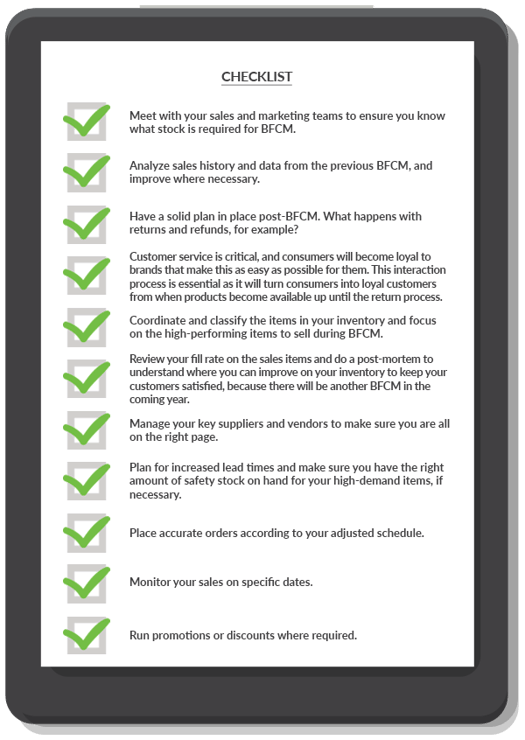Oct 13, 2021
Prepare for Black Friday and Cyber Monday 2021

Black Friday and Cyber Monday happen every year at the end of November. Is your business prepared for these events, and how does it affect your supply chain and demand planning?
It’s that time of the year again - yes, you guessed it! Black Friday and Cyber Monday (BFCM) are on November 26 and 29, but will it be as prominent as previous years? Having first emerged in the US in the 1950s, BFCM has taken the world by storm by creating a “global shopping spree,” and retailers (and consumers) are once again gearing up for sales and deals the second year during a pandemic.
According to Lifehacker, a weblog for lifehacks and software, “Due to pandemic-related supply chain issues, you should expect fewer bargains and depleted inventory when you do your holiday shopping this year. But some retailers think it is going to be worse than that, and are already telling their customers “September is the new December” and that they should start shopping now, as some products may be very hard to find come November and December.”
We at NETSTOCK predict that Black Friday deals will be scarce as businesses grapple with product shortages, overall increased demand, and logistical issues.
inews, a daily newspaper in London, agrees and says, “Promotional events such as Black Friday trigger a huge spike in consumer demand, but only for a short time, and the effect of this activity on operations is huge… You need more people in warehouses but for a very short amount of time.”
Let’s look at how your supply chain will be affected by BFCM.
1) How does BFCM this year compare to last year?
According to a report by PricewaterhouseCoopers, a global professional services network, on Black Friday 2018, sales increased by 1,952% compared to regular shopping days. It has gained momentum and traction with consumers, and the trend was heading up in 2019. However, COVID-19 has changed the trajectory.
Black Friday sales plummeted for brick and mortar stores in 2020 in South Africa, as shoppers avoided stores and retailers offering online deals and discounts due to the infection risk and unemployment. Online sales increased by 60%, but the spending was not nearly enough to offset the loss in in-store sales. Similarly, in the USA, RetailNext says, “traffic data show that visits to brick and mortar stores during the Black Friday weekend in 2020 decreased by 49% compared to 2019.”
However, we are resilient and persistent, and we have adapted to a new way of living and thinking. The most significant difference is the increased activity in online spending and sales as consumers begin to trust online platforms.
BFCM insight: This year, the ease of purchasing, user-friendly interfaces, excellent customer service delivery, and hassle-free return policies will help drive online engagement, sales, and traffic.
2) Black Friday and Cyber Monday is an opportunity knocking at your door
One thing that your business can be sure of approaching BFCM is the fact that there is real intent among consumers to spend, and that is an opportunity knocking at your door.
From a logistics and supply chain perspective, it can be your business’s worst nightmare, but from a bottom-line perspective, you could have a fairytale ending that makes you jingle to the bank.
It’s the ideal time to capitalize on increased traffic and sales. There will be repeated sales for the holiday season, which offsets the discounts from BFCM. Retailers can clear their stock and excess stock before the holiday season and make room for newer, updated products.
BFCM insight: If you have excess inventory, items that just aren't selling, or discontinued products, it's time to offer your consumers a discount.
3) What are the advantages of BFCM?
It’s unlikely that consumers will queue to spend money on items that have gathered dust in warehouses and have hardly been touched throughout the year. This does not mean that you can’t take a strategic approach to BFCM. Adobe notes, “If we look at 2020, predictions for Black Friday revenue in the US were set at $184 billion, up from the record $142.4 billion set in 2019. The final numbers for 2020 reached as high as $188 billion.”
BFCM advantages:
- If you are severely overstocked in some areas, try bundling slow-moving or underperforming items with fast-moving, high-performing items in your business to try and clear out some of the dust gatherers, and release capital tied up in your business.
- Clear out the items not producing results in the business.
- Use excess stock as promotional gifts as a way of clearing out the products mentioned above.
4) How will supply chain disruptions affect demand this year?
With global supply chains facing ongoing disruptions, retailers will have to gear up for increased consumer demand sooner rather than later.
Vox Media, a mass media company in the US, says, “Companies are struggling to unpack shipping containers and get them back into circulation. As a result, shipping containers are in short supply, even though there should be enough containers to handle global demand. Too many are just stuck in circulation and stay unused.”
Lifehacker believes the following products will be the most affected by supply chain disruptions this year:
- Microchip shortages will limit the supply of electronics until the end of 2021.
- Paper shortages and shipping delays will affect the book publishing industry. Retailers should encourage consumers to buy books before BFCM and opt for older books already available in stores.
- Toy shortages may occur until Christmas this year!
- Supply chain disruptions will affect the clothing industry to a massive extent as fashion giants face an inventory crisis and may run out of clothing and shoes.
BFCM insight: Consider your most important items and classify these items into A, B, and C categories accordingly to help you plan for increased consumer demand.
5) Your BFCM inventory checklist
Supply chain disruptions will continue well into the first quarter of 2022. Your forecasting, planning, and ordering should occur well in advance. Companies that previously had a two-month lead time on imports are now working on a 24-month planning horizon due to lead times that changed to six months or more before delivery of a placed order. Consumers plan for BFCM at least a year in advance, and they make price comparisons well before the time to know if they are getting a good deal or not. If the average consumer plans ahead, companies should also plan to capitalize on events like BFCM.
We recommend doing the following:

Make the most of BFCM 2021 by being prepared and planning ahead! If you’re struggling to forecast accurately and place orders in advance, consider using a cloud-based demand planning solution and make the most of your inventory planning!
Get your free price quote today!
Written by Adri Du Plessis
Adri du Plessis is the Sales Development Representative for NETSTOCK South Africa. Passionate about helping businesses navigate supply chain disruptions, Adri is responsible for creating value as a source of information for potential clients that engage with NETSTOCK, and determining when a potential client is ready to engage with the sales team.


